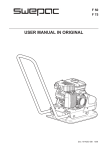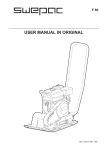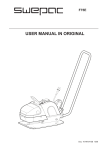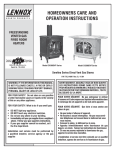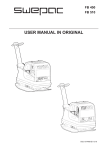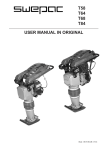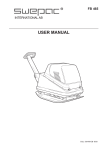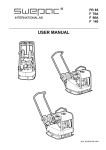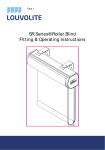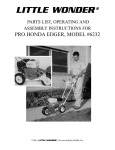Download F50_F75 manual ENG
Transcript
F 50 F 75 USER MANUAL Doc: 101425A-GB 0925 Doc: 101425A-GB 0925 F50F/ 50 F75 2 F50 / F75 F 50 USE SWEPAC F 50 / F75 is used to pack gravel and sand in connection with minor construction work such as the basis for concrete blocks or paving stones for gardens. The machine’s compact design ensures good accessibility in tight spaces. We reserve the right to modify our design and material specifications without prior notice. CONTENTS Doc: 101425A-GB 0925 USE .......................................................................... 3 SAFETY INSTRUCTIONS...................................... 4 STANDARDS . ........................................................ 4 SIGNS ...................................................................... 5 TECHNICAL DATA................................................. 6 FUNCTION.............................................................. 6 TECHNICAL DESCRIPTION................................. 7 DAILY CHECKS...................................................... 8 BEFORE STARTING VANGUARD ENGINE........ 9 STARTING............................................................... 9 AFTER STARTING.................................................. 9 STOPPING............................................................... 9 OPERATING INSTRUCTIONS.............................. 9 BEFORE STARTING HONDA ENGINE.............. 10 STARTING............................................................. 10 AFTER STARTING................................................ 10 STOPPING............................................................. 10 TRANSPORTATIONS........................................... 11 3 F50F /50 F75 SAFETY INSTRUCTIONS STANDARDS • Before using the machine, the operator must be informed Noise of the manufacturer’s safety instructions and instructions Measurement in accordance with the standard EN 500-4 for use. Rev. 1:1998, Annex C: • The machine may only be used outdoors. • The machine may not be used if protection and safety devices are not present or not working. • The operator may not leave the machine unattended when the engine is on. When the vibrator is connected, the operator must be able to control the movement of the machine using the control handle and the start/stop controls. The machine may be operated only by a trained operator. • During maintenance work or other interventions in the machine, the engine must always be off. • Switch the engine off before adding fuel. Avoid fuel spillage and immediately wipe off any spilled fuel. Add fuel only in well ventilated areas. • Avoid touching hot engine parts, for example the silencer. • Before lifting the machine, check that the lifting device and its mounting are not damaged and that the rubber dampers on the base plate are undamaged and tightened. • During transportation and storage, the fuel tank should be empty and the fuel cock switched off. • The operator must use ear protectors when working with the machine. In accordance with the conditions in Directive 2000/14/EC, Annex VI, the following values are reported: F 50 F 75 Sound pressure level 89 dB (A) at the operator’s ears, 89 dB (A) LpA permitted sound 105 dB (A) power level, L WA 105 dB (A) Guaranteed sound 105 dB (A) power level, L WA 105 dB (A) As the sound pressure level at the operator’s ears exceeds 85 dB (A), ear protectors must be used during operation! Hand/arm vibrations The vibration acceleration was measured in accordance with the ISO 5349 standard during operation on a graveled surface. The measurement values were translated into the maximum daily exposure time for regular usage. For additional information about vibrations, please confer the regulation AFS 2005:15 from the Swedish Work Environment Authority, effective July 1st 2005. F 50 F 75 Hand/armvibrations, m/s2 4,5 4,6 The maximum daily exposure time 2,5 h 2,4 h • The operator must ensure that no unauthorised persons are in the immediate vicinity of the machine. Doc: 101425A-GB 0925 Exhaust emissions F 50 meets the requirements for California ExH, EYP och EPA PH2 F 75 meet the requirements for exhaust emissions in acoordance with EU directive 2002/88 Euro2 4 F50 / F75 F 50 SIGNS Warning signs Machine Signs 1 2 3 4 8 5 Before use, carefully read the manual and its safety instructions so that you can handle the machine safely. Ensure that the manual is always accessible. 7 1. 2. 3. 4. 5. 6. 7. 8. 6 Manufacturer Place, country of manufacture. CE mark. Model name. Year of manufacture. Max. engine power. Max. weight. Serial number. Engine, silencer: to avoid burns or discomfort, do not touch hot engine parts when the engine is on or when the machine has recently been used. Doc: 101425A-GB 0925 Belt drive: Keep hands, tools and other objects away from the belt drive when the machine is on to avoid injury and damage. See the safety instructions in the manual. As the sound pressure level at the operator’s ears exceeds 85 dB (A), ear protectors must be used when working with the machine to prevent hearing damage. 5 F50 / F75 F 50 TECHNICAL DATA F 50 Net weight..................................52 kg Base plate, w x l ........................300 x 500 mm Speed..........................................appr 25 m/min Centrifugal force........................9 kN Handle vibrations.......................115 Hz Drive engine...............................Vanguard Engine power.............................1,8 kW Engine RPM...............................3600 RPM Fuel tank volume........................1,6 liter Fuel type.....................................Unleaded petrol or alkylatet Oil quantity, crankcase...............0,4 liter FUNCTION The machine consists of a base plate with a vibration element and an upper part cushioned from the base plate. The power is transmitted from the petrol engine to the vibration element via a V-belt. The engine is fitted with an integrated centrifugal clutch. On account of the direction of rotation and the position of the vibration element at the front end of the base plate, the vibrator moves forward under its own power. The moving parts are well protected by a cover made of impact resistant polythene. F 75 Net weight..................................75 kg Base plate, w x l ........................380 x 530 mm Speed..........................................appr 25 m/min Centrifugal force........................11 kN Handle vibrations.......................94 Hz Drive engine...............................Honda Engine power.............................2,9 kW Engine RPM...............................3600 RPM Fuel tank volume........................2,5 liter Fuel type.....................................Unleaded petrol or alkylatet Oil quantity, crankcase...............0,6 liter FUEL AND OIL RECOMMENDATIONS Doc: 101425A-GB 0925 Fuel...............................Unleaded petrol or alkylate Engine oil......................SAE10W-30 6 F50F/ 50 F75 TECHNICAL DESCRIPTION 1 3 2 5 8 9 7 10 6 4 Handle Protective cover Petrol engine Rubber damper Vibration element Base plate Engine plate V-belt Centrifugal clutch Lifting eye Doc: 101425A-GB 0925 1. 2. 3. 4. 5. 6. 7. 8. 9. 10. 7 F50 F 50/ F75 DAILY CHECKS Fuel Check Check that there is fuel in the tank. Top up if necessary. Engine Oil Level Check Check the oil level in the crankcase every day. The oil must reach the edge of the filling hole when the machine is on a level surface. V-belt Drive Check the tension and condition of the V-belt regularly. Replace a damaged V-belt with the new type Z25 for F50 and A28 for F75. 2 Air Filter Check Vanguard The air filter must be checked at least once every working week. When working in dusty conditions, check daily. 4 1 3 Adjustment of V-belt tension Loosen the screws (1, 4 pcs) that hold the engine plate. Loosen the screws (2, 3 pcs) holding the cover. Remove the cover. 4 3 2 1 Cleaning the air filter 1. Loosen screws (1) and remove the cover (2). Clean the dust off the cover 2. Clean the pre-cleaner (3) with cleanser and water. Saturate the precleaner in engine oil. Squeeze dry in clean absorbent cloth. 3. Clean the cartridge (4) by tapping it gently on a flat surface. NOTE! Renew a damaged cartridge. 4. Make sure that the aluminum plate (5) is remounted according to illustration. 5. Remount the filter unit in opposit order.. Air Filter Check Honda The air filter must be checked at least once every working week. When working in dusty conditions, check daily. 1. Paper element 2. Foam plastic element Cleaning the air filter 1. Remove the foam plastic element and the paper element and check that they are undamaged. Replace damaged parts. 2. Wash the foam plastic element in liquid with a high flashpoint and let it dry properly. Dip in engine oil and squeeze dry. 3. Strike the paper element against a hard object a few times to loosen any dirt. Oil/Fuel Leakage Check every day that the engine is not leaking oil or fuel. If a leak is discovered, the machine may not be operated until the fault has been remedied. See also the separate engine instructions! 8 Rubber Dampers Check the condition of the rubber dampers (4, 4 pcs) regularly. Replace damaged dampers. Polyuretan Pad A polyuretan pad is used for stone paving work to protect against stones and ground clinker. 1 2 Doc: 101425A-GB 0925 5 Tension the V-belt by pulling the handle (3). Tighten the screws. Refit the cover. F50F /50 F75 Oil level Starting handle Engine switch Choke Fuel shut-off valve BEFORE STARTING VANGUARD ENGINE NOTE! The machine is equipped with an oil guard, which switches off the engine if the oil level is too low. Always check the oil level if the machine cannot be started. Fill up oil to the FULL-mark on the dipstick. Also see Daily Checks on page 8. STARTING Set the choke to CHOKE-position. Set the throttle lever to FAST-position. Open the fuel shut-off valve. Move the engine switch to position I. Start by pulling the starting handle. Throttle lever OPERATING INSTRUCTIONS The machine’s vibration elements start when the throttle is increased. The best packing is achieved at full engine RPM. Avoid running the engine at other RPM as there is a risk of the clutch slipping, with abnormal wear as a result. Thanks to its compact design and low weight, the machine’sis very easy to manoeuvre. The design of the base plate allows the machine to be pulled backwards without disturbing the packed surface. The machine’s vibration element stops when the throttle is switched to idle. The machine is only designed to be used outdoors. Work with the machine in daylight or other adequate lighting. Ballast must be wetted or naturally damp. All other use is discouraged. AFTER STARTING Open the choke gradually. Run the engine warm for around 5 minutes. STOPPING Switch the engine to idle and let it run for a few minutes. Doc: 101425A-GB 0925 Shut off the engine, by setting the red engine switch to position O. 9 F50 F 50/ F75 Off On Oil level Off On Fuel cock Engine power switch Idle Full RPM Throttle lever Closed Open Choke BEFORE STARTING HONDA ENGINE AFTER STARTING See Daily Checks on page 8. Switch the throttle lever to idle. Open the choke gradually. STARTING Switch the engine power switch to “on”. Open the fuel cock. Switch the throttle lever to 1/3 of full RPM. Adjust the choke. If the engine is cold, close the choke completely. Do not use the choke if the engine is warm or if the air temperature is high. STOPPING Switch the engine to idle and let it run for a few minutes. Switch the engine power switch to “off”. Close the fuel cock. Doc: 101425A-GB 0925 Start by pulling the starting handle. Pull it first until the mechanism engages. Then pull it hard and fast. Run the engine warm for around 5 minutes. 10 F50F /50 F75 TRANSPORTATION It is easy to remove the handle witout tools, and the boot of a standard car is sufficient to transport the machine. Lifting by hand Remove the handle by tilting it forward and pulling the shafts apart. Move the handle from side to side so that the dowels let go. Transport locking Secure the machine with straps accorrding to illustration during transportation Note! Secure it by the base plate and not the rubbercushioned upper part. Caution!The machine must be lifted by 2 persons! Lift by means of the handle on the back and the front edge of the machine. Doc: 101425A-GB 0925 Lifting with crane Tilt the handle forward. Fit a lifting sling to the lifting eye and thread the lifting sling between the shafts of the handle, see illustartion below. 11 SWEPAC INTERNATIONAL AB Address Box 132, 341 23 Ljungby, Sweden, tel. +46 (0)372-156 00, fax +46 (0)372-837 41, E-mail [email protected], Internet www.swepac.se














